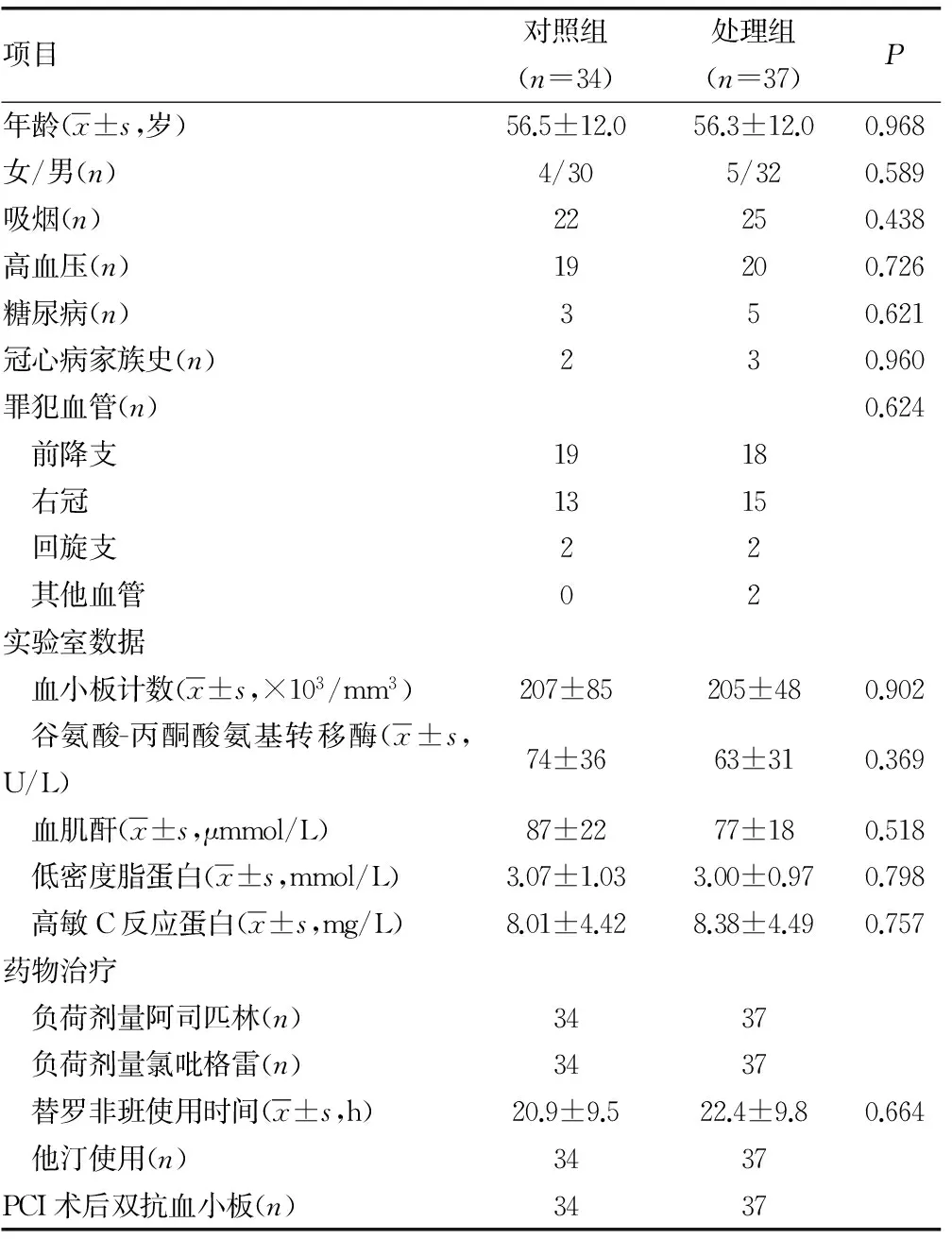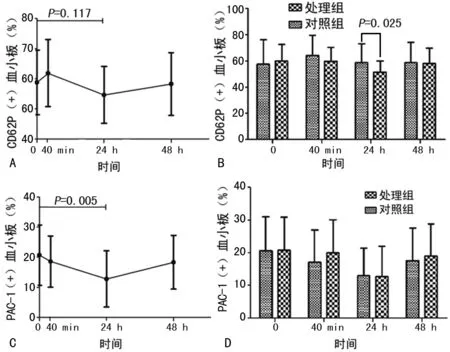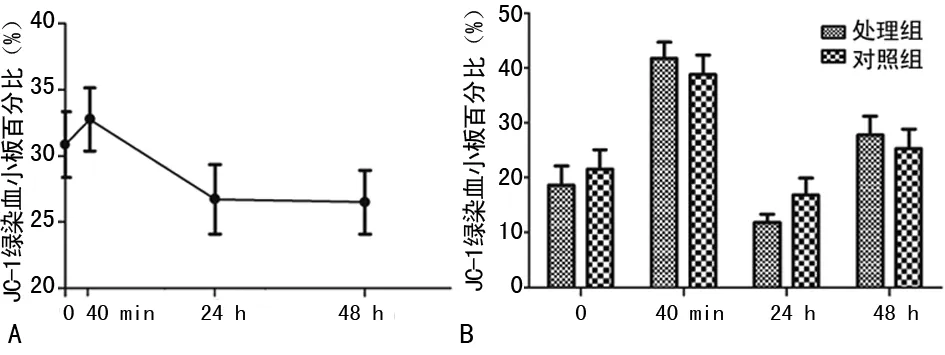远隔缺血后适应对急性心肌梗死再灌注治疗患者血小板功能的影响*
2018-01-05钱云霞何志松杨向军
钱云霞,何志松,杨向军
(苏州大学附属第一医院心内科,江苏苏州 215006)
论著·临床研究
远隔缺血后适应对急性心肌梗死再灌注治疗患者血小板功能的影响*
钱云霞,何志松,杨向军△
(苏州大学附属第一医院心内科,江苏苏州 215006)
目的探讨远隔缺血后适应(RIPostC)对急性心肌梗死再灌注治疗患者血小板功能的影响。方法入组2015年6月至2016年7月该院71名急性心肌梗死患者,均接受再灌注治疗。患者分为两组:处理组,接受RIPostC;对照组,接受假RIPostC。在经皮冠状动脉介入术(PCI)之前、RIPostC后即刻、PCI术后24 h、PCI后48 h采集患者的静脉血样,用流式细胞仪检测血小板活化指标CD62P 和PAC-1,和血小板凋亡指标线粒体跨膜电位(ΔΨm)。结果处理组PCI术后24 h血小板表面CD62P的表达明显低于对照组(P<0.05),而在其他时间点两组差异无统计学意义(P>0.05);两组血小板PAC-1表达在各个时间点差异无统计学意义(P>0.05);两组患者血小板ΔΨm在各时间点差异也无统计学意义(P>0.05)。结论RIPostC能一定程度降低急性心肌梗死患者血小板的活化,不引起血小板早期凋亡。
心肌梗死;血小板活化;缺血后适应
急性心肌梗死最重要的治疗方法是尽快恢复心肌的血液再灌注,但是再灌注治疗有时候会引起组织细胞更大的损伤,这种现象称之为缺血再灌注损伤[1]。既往研究表明,远隔器官或组织的短暂性缺血能够减少急性心肌梗死患者的心肌损伤,这种现象称远隔缺血适应。
远隔缺血适应包括:远隔缺血预适应(remote ischemic preconditioning,RIPreC)和远隔缺血后适应(remote ischemic postconditioning,RIPostC)。两者都能减少心肌细胞的再灌注损伤[2-5]。RIPreC需要在事件发生之前运用,因为难以预测事件何时发生,所以这在实践中难以做到;而RIPostC在事件发生后立即实施,这一方法既安全、易行。有研究表明,血小板在缺血再灌注损伤中扮演重要的角色[6-7]。目前有研究表明RIPreC能降低人体血小板的活性[8-9],而尚没有研究揭示RIPostC对人体血小板功能的影响。所以本研究的目的在于明确RIPostC对急性心肌梗死患者血小板功能的影响。
1 资料与方法
1.1一般资料 本研究主要入组2015年6月至2016年7月本院接受再灌注治疗的急性ST段抬高心肌梗死患者。入组标准:(1)急性ST段抬高心梗;(2)首诊90 min内接受经皮冠状动脉介入术(percutaneous coronary intervention,PCI)治疗。排除标准:(1) 既往无心肌缺血事件;(2) 无严重的肝肾功能不全;(3) 无血液系统疾病;(4) 无合并感染。71例患者纳入研究,分为:处理组(n=37)接受RIPostC,对照组(n=34)接受假RIPostC。所有患者均签署书面的知情同意书,此研究通过医院的医学伦理委员会批准。
1.2心肌再灌注治疗 所有入组患者均接受急诊PCI手术再灌注心肌。所有患者在术前均服用300 mg 阿司匹林和300 mg氯吡格雷抗血小板治疗,术后每天服用100 mg阿司匹林和75 mg氯吡格雷。在术中和术后接受短时间低剂量(5 μg·kg-1·h-1)的替罗非班治疗(21±10)h。
1.3RIPost C方法 所有入选患者在本院心血管内科导管室接受急诊PCI术治疗。术中对闭塞的罪犯血管实施第1次球囊扩张后3 min内应用RIPostC或假RIPostC。处理组用血压计袖带包绕患者一侧上臂进行充气加压,充气至200 mm Hg维持5 min,然后放气至0 mm Hg维持5 min,此为1个循环,一共进行4次循环;对照组用血压计袖带包绕患者一侧上臂,充气至5~10 mm Hg维持5 min,然后放气至0 mm Hg维持5 min,也进行4个循环。
1.4血小板功能检测 (1)血小板的准备:在PCI手术前、RIPostC/sham RIPostC后即刻、PCI后24 h、PCI后48 h 4个时间点分别抽取患者静脉血样5 mL。富含血小板血浆和缺乏血小板血浆分别用不同的离心力制备(200×g,10 min 和1 300×g,15 min)。富含血小板血浆的血小板计数调整到3.0×1011/L。(2)血小板活化指标CD62P 和PAC-1 用流式细胞仪测定:富含血小板血浆加入 5 μL FITC标记的 P选择素(BioLegend,USA) 在37 ℃暗室孵育15 min;5 μL富含血小板血浆加入 10μL FITC标记的 PAC-1(Becton Dickinson,USA) 在37 ℃暗室孵育15 min,然后用流式细胞仪(Beckman XL)检测。(3)血小板线粒体膜电位的监测:在50 μL 富含血小板血浆加入 2 μmol/L JC-1在37 ℃暗室孵育15 min后上流式细胞仪检测,用绿色荧光所占百分比来反映线粒体膜电位的变化。

2 结 果
2.1患者的临床资料 两组患者的冠心病的常见危险因素、罪犯血管、肝肾功能、低密度脂蛋白、血小板计数、药物治疗等。临床特征差异无统计学意义。两组患者的主要临床特征见表1。

表1 两组患者临床特征
2.2血小板的活化指标 (1)处理组PCI术后24 h血小板表面CD62P的表达明显低于对照组(51.1±8.6)%vs.(58.5±14.6)%(P=0.025),而在其他时间点两组差异无统计学意义(P>0.05);(2)两组血小板PAC-1表达在各个时间点差异无统计学意义(P>0.05);(3)所有入组患者术后24 h血小板CD62P和PAC-1表达率最低。见表2和图1。
2.3血小板线粒体膜电位的变化 线粒体膜电位的变化与血小板早期凋亡相关,两组患者的血小板线粒体膜电位变化在各个时间点差异无统计学意义(P>0.05)。见表2和图2。

表2 两组患者血小板活化指标比较

A:入组所有患者的CD62P表达随时间变化趋势;B:处理组和对照组在不同时间点CD62P表达比较;C:入组所有患者的PAC-1表达随时间变化趋势;D:处理组和对照组在不同时间点PAC-1表达比较
图1 CD62P(+)和PAC-1(+)血小板的表达

A:入组所有患者48 h内 JC-1绿染的血小板百分比随时间变化趋势;B:处理组和对照组在不同时间点JC-1绿染的血小板百分比对比
图2 JC-1绿染的血小板百分比
3 讨 论
急性心肌梗死最有效的治疗方法是及时再灌注治疗,但是再灌注治疗的同时往往伴随着再灌注损伤。降低血小板活性是减轻心肌再灌注损伤重要机制之一。先前的研究已证明,RIPreC可降低血小板的反应性。因为RIPreC在临床实践中不易开展,所以本研究探讨RIPostC对血小板是否有相同的效应。
CD62P和 PAC-1 均为国内外公认的血小板活化标志物[10]。在本研究中,入选的患者均为急性ST抬高心梗患者并且接受PCI再灌注治疗。其中RIPostC组,血小板CD62P的表达在术后24 h低于对照组,而在其他各个时间点两组间差异无统计学意义。而两组患者血小板PAC-1在各个时间点差异均无统计学意义。说明RIPostC能降低血小板CD62P的表达,而不能降低PAC-1。这是RIPostC对血小板作用不明显还是因为其他原因还不得而知。本研究中,所有患者均接受了三联抗血小板的治疗,所以RIPostC未显示出对PAC-1的影响。但是血小板CD62P表达在术后24 h在两组患者间还是显示出了差异性,提示RIPostC减少了血小板α 颗粒的脱颗粒与释放。RIPostC对CD62P 与PAC-1 的不同影响可能存在以下几个原因:(1)目前有研究表明抗血小板药物对GPⅡb/Ⅲa的影响大于CD62P[11];(2)PAC-1是早期活化的标记物,而CD62P是活化后期的标记物。在本实验中RIPostC对血小板的早期影响可能被药物所掩盖(其中替罗非班平均使用21 h),所以在PCI 术后24 h,RIPostC对血小板的影响才显现出来。而在PCI术后48 h,血小板活化指标在两组患者间差异无统计学意义(P>0.05),推测RIPostC对血小板的影响持续时间不能达到48 h。
另外,抗血小板药物使用过程中可能存在出血的并发症。所以本研究也观察了RIPostC对血小板凋亡的影响。通过JC-1从红色荧光到绿色荧光的转变作为细胞凋亡早期的一个检测指标。在两组患者间,JC-1绿染的血小板百分比差异无统计学意义,说明RIPostC未引起血小板的凋亡。
目前RIPostC对血小板功能影响的机制尚不明确。 RIPostC对缺血心肌的保护机制表明,远隔器官释放一些体液因子:如腺苷、阿片类物质、缓激肽、内源性NO等,通过传入神经或血液循环作用于心脏,实现其心肌保护作用,其中内源性腺苷是非常重要的物质之一[12]。现有的研究表明,RIPreC对血小板的影响主要是通过内源性腺苷的释放及其A2a受体的激活。应用腺苷受体拮抗剂茶碱类物质可使RIPreC对血小板的效应消失[8-9]。进一步研究表明,腺苷通过激活血小板表面的Gs蛋白偶联的A2a受体,激活腺苷酸环化酶,导致血小板内环磷酸腺苷增加,钙离子水平降低,从而抑制血小板活性[13-14]。所以笔者推测RIPostC对血小板功能的影响,可能也是通过远隔器官释放内源性腺苷,并激活其血小板表面A2a 受体发挥作用。
[1]Moens AL,Claeys MJ,Timmermans JP,et al.Myocardial ischemia/reperfusion-injury,a clinical view on a complex pathophysiological process[J].Int J Cardiol,2005,100(2):179.
[2]Wei M,Xin P,Li S,et al.Repeated remote ischemic postconditioning protects against adverse left ventricular remodeling and improves survival in a rat model of myocardial infarction[J].Circ Res,2011,108(10):1220-1225.
[3]Lavi S,D′Alfonso S,Diamantouros P,et al.Remote ischemic postconditioning during percutaneous coronary interventions:remote ischemic postconditioning-percutaneous coronary intervention randomized trial[J].Circ Cardiovasc Interv,2014,7(2):225-32.
[4]Xiong J,Liao X,Xue FS,et al.Remote ischemia conditioning-an endogenous cardioprotective strategy from outside the heart[J].Chin Med J(Engl),2011,124(14):2209-2215.
[5]Xu J,Sun S,Lu X,et al.Remote ischemic pre- and postconditioning improve postresuscitation myocardial and cerebral function in a rat model of cardiac arrest and resuscitation[J].Crit Care Med,2015,43(1):e12-18.
[6]Xu Y,Huo Y,Toufektsian MC,et al.Activated platelets contribute importantly to myocardial reperfusion injury[J].Am J Physiol Heart Circ Physiol,2006,290(2):H692.
[7]Mirabet M,Garcia-Dorado D,Inserte J,et al.Platelets activated by transient coronary occlusion exacerbate ischemia-reperfusion injury in rat hearts[J].Am J Physiol Heart Circ Physiol,2002,283(3):H1134-1141.
[8]Battipaglia I,Scalone G,Milo M,et al.Upper arm intermittent ischaemia reduces exercise-related increase of platelet reactivity in patients with obstructive coronary artery disease[J].Heart,2011,97(16):1298-1303.
[9]Stazi A,Scalone G,Laurito M,et al.Effect of remote ischemic preconditioning on platelet activation and reactivity induced by ablation for atrial fibrillation[J].Circulation,2014,129(1):11-17.
[10]Bigalke B,Lindemann S,Gawaz M.Platelet activation in acute coronary syndrome and interventional therapy[J].Hamostaseologie,2007,27(5):338-343.
[11]Goto S,Tamura N,Li M,et al.Different effects of various anti-GPⅡb-Ⅲa agents on shear-induced platelet activation and expression of procoagulant activity[J].J Thromb Haemost,2003,1(9):2022-2230.
[12]Kaur S,Jaggi AS,Singh N.Molecular aspects of ischaemic postconditioning[J].Fundam Clin Pharmacol,2009,23(5):521-536.
[13]Fuentes E,Pereira J,Mezzano D,et al.Inhibition of platelet activation and thrombus formation by adenosine and inosine:studies on their relative contribution and molecular modeling[J].PLoS One,2014,9(11):e112741.
[14]Suzuki T.Hetero-oligomerization and functional interaction between purinergic receptors expressed in platelets to regulate platelet shape change[J].Yakugaku Zasshi,2015,135(12):1335-1340.
Effectofremoteischemicpostconditioningonplateletfunctioninpatientswithmyocardialischemia-reperfusion*
QianYunxia,HeZhisong,YangXiangjun△
(DepartmentofCardiology,FirstAffiliatedHospitalofSuxhouUniversity,Suzhou,Jiangsu215006,China)
ObjectiveTo investigate the effect of remote ischemic postconditioning (RIPostC) on the platelet reactivity in the patients with acute myocardial infarction(AMI) receiving reperfusion therapy.MethodsSeventy-one cases of AMI entering the group
the reperfusion therapy.The patients were divided into the two groups.The treatment group received RIPostC,while the control group received sham RIPostC.The venous blood samples were collected before transcutaneous coronary intervention(PCI),instantly after RIPostC and at 24 h,48 h after PCI.The platelet activation indicators CD62P and PAC-1,and platelet apoptosis indicator mitochondrial transmembrane potential(ΔΨm) were measured by flow cytometry.ResultsCD62P expression on platelet surface at 24 h after PCI in the treatment group was significantly lower than that in the control group(P<0.05),but which at other time points had no statistical difference between the two groups(P>0.05);there was no statistical difference in platelet PAC-1 expression at each time point between the two groups(P>0.05);the platelet ΔΨm at each time point had no statistical difference between the two groups(P>0.05).ConclusionRIPostC can somewhat reduce platelet activation in AMI patients without causing platelet early apoptosis.
] myocardial infarction;platelet activation;ischemic postconditioning
10.3969/j.issn.1671-8348.2017.36.011
国家自然科学基金资助项目(81400200)。
钱云霞(1978-),主治医师,博士,主要从事冠心病的研究。△
,E-mail:yang_xiangjun@163.com。
R541.4
A
1671-8348(2017)36-5071-03
2017-08-20
2017-09-22)
